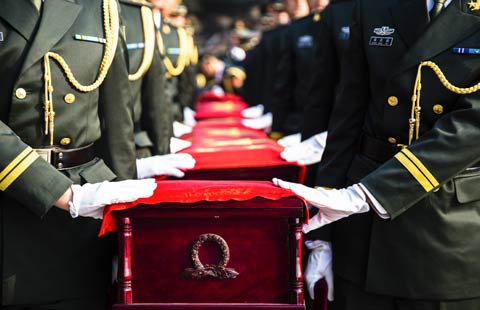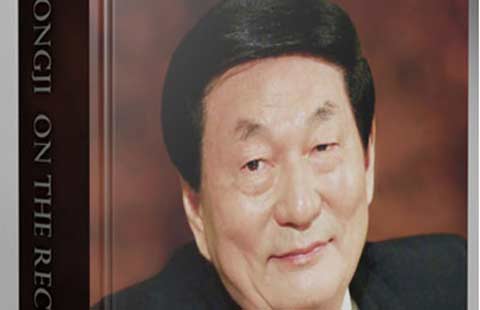Mystery of Halloween still haunts scholars
Updated: 2014-10-30 11:44
By Chris Davis(China Daily USA)
|
||||||||
Chinese Halloween - Zhongyuan Jie, or the Ghost Festival - falls on the 15th day of the seventh month, which, in this year of the Chinese lunar calendar, 4712, was Aug 10. And it's always a full Moon.
Though the timing of the two spooky holidays is off, they share intriguing parallels.
Halloween in the West has its roots in ancient Greek mythology. Greeks believed that when people died, they went to the banks of the River Styx, the boundary between Earth and the Underworld, gave the ferryman Charon a tip and were transported across the river to Hades, where they would spend eternity.
If people had lived a good life, they would get a two-part reward. First, they would reside in Elysium, a virtual paradise. Second, one day a year, they would be allowed to return to the world of the living.
Under Christianity, this myth underwent a conversion. The good and righteous people became saints, and their day to get to come back for a visit was set, for some reason, at Nov 1 Saints, or the hallowed ones, would be welcomed with all sorts of honors, praise and prayer, including the courtesy of shooing away any evil or unpleasant spirits that might be loitering around the day before. So All Hallowed Eve became Halloween, where otherwise sane and normal people go out of their way to be frightening to scare away the ghouls.
In the Chinese tradition, Zhongyuan Jie also celebrates the connection between the living and the dead and dates back about 2,000 years to the Han Dynasty. It is also a day when the gates separating the realms of Heaven and Hell and the living are thrown open and the dead can visit the living. Families prepare elaborate favorite dishes for their departed ancestors and leave empty seats for them at the table. They light bonfires and lanterns to help spirits find their way and burn incense to please them. Buddhist and Taoist priests chant and pray for the wanderers.
The Chinese tradition also includes the concept of the pretas, who, according to various sources, are the forlorn spirits of people who died at sea or accidentally and, never getting a proper burial, were doomed to wander through the land of the living and never be released to heaven. Preta is actually a Sanskrit term which the Chinese adapted to egui, or hungry ghosts, a wonderfully Halloween-ish term in any language.
These spirits roam the Earth in search of the peace they were deprived of by not having a grave where people could visit and leave offerings. The legend goes that they feel cheated and can be bitter and angry and try to take it out on the living. The Festival of the Hungry Ghosts is an attempt to mollify them, make them feel welcomed and ease their hostility. Gifts are made of paper in the shapes of things they may have had while among the living to make them feel at home. Making a hungry ghost happy brings good luck and fortune.
Some scholars trace the lore back to the Buddhist Ullambana Sutra, which tells the story of a psychic monk and disciple of the Buddha who had a vision of his deceased parents one day. His father, who had lived a good life and left his mother wealthy, was residing happily in Heaven. But his mother, who had been selfish with the fortune left her and had not made offerings to the priests, was suffering in Hell, or the realm of the Hungry Ghosts, who were tormented by constant, gnawing hunger which they could never appease because their mouths were too small and throats too fragile.
Distressed, the monk went to the Buddha asking what he could do to ease his mother's suffering. The Buddha instructed him to place food on a clean plate, bless it with a mantra, call up the dead by snapping his fingers and then drop the food onto the ground. Which apparently worked. Trick or Treat?
A writer once said that the ocean of mankind's lore is fed by all rivers and bathes all shores. Where legends come from, how they've intermingled over the eons and how they remind us of all that we have in common with each other is a fascinating mystery.
As the great China historian Endymion Wilkinson writes in his China History: A New Manual: "An historical atlas of Chinese cults and festivals does not exist. If one ever could be made, it would provide a rich feast."
Contact the writer at chrisdavis@chinadailyusa.com.
(China Daily USA 10/30/2014 page3)
- Xinjiang publishes anti-terror brochures
- Security pact sealed with Afghanistan
- President Xi encourages international cultural exchanges
- Premier Li: China willing to help Afghan infrastructure
- Chinese FM: China, Asia-Pacific become community of shared destiny
- Foreign minister remarks on possibility of China-Japan summit

 Jack Ma: sports fan or the next mogul?
Jack Ma: sports fan or the next mogul?
 Hawaii lava crosses residential property
Hawaii lava crosses residential property
 Obama praises health workers fighting Ebola as 'heroes'
Obama praises health workers fighting Ebola as 'heroes'
 Chinese community still angry after double-murder conviction
Chinese community still angry after double-murder conviction
 Chinese tourists to US to reach 20m in 2020
Chinese tourists to US to reach 20m in 2020
 SOHO endows $10m to Yale
SOHO endows $10m to Yale
 Remains of Chinese volunteer force buried in Shenyang
Remains of Chinese volunteer force buried in Shenyang
 Former premier makes Hurun philanthropists list
Former premier makes Hurun philanthropists list
Most Viewed
Editor's Picks

|

|

|

|

|

|
Today's Top News
Probe started over US rocket explosion
Hagel: China, US should get relationship right
Cheating probe delays SAT scores
Chinese tourists to US to reach 20m
Tycoons' gift to Yale stirs debate
VW defends safety of recalled New Sagitar
Former premier makes Hurun philanthropists list
Xinjiang publishes anti-terror brochures
US Weekly

|

|








